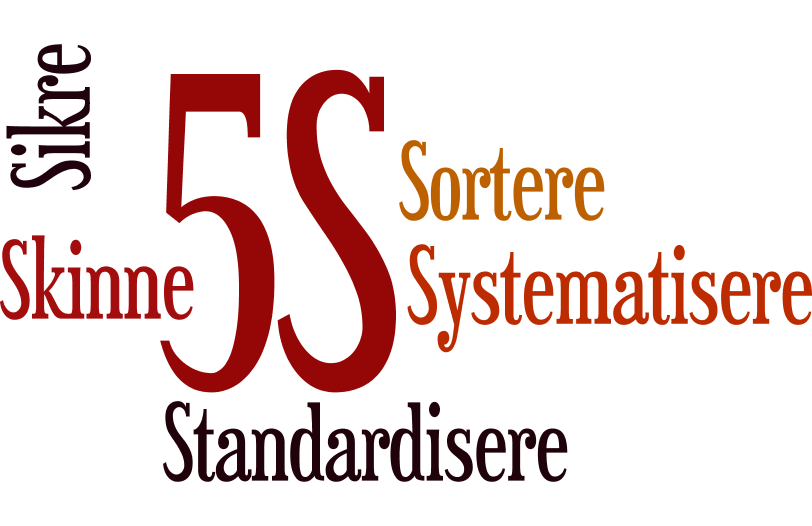
What is 5S?
5S is a basic part of the Lean philosophy. 5S is a practices that aims to create a structured and clean workplace. This implies among other things at irritation and loss of time, material and other resources due to a lack of order is reduced to a minimum.
5S stands for sort, straighten, shine, standardise, and sustain. In practice, this means that all tools, materials and requipment etc. on the workplace are carefully reviewd and sorted. It is focused on fixed storage areas, order and that it is tidy and efficient for the individual and the department overall. 5S also ensured regular procedures for systematic cleaning, so that all tools, equipments and materials will be put back to their regular place after use. This will be a part of the daily routines and based on random burst.
Standardized tasks
One thing that is emphasized is the standardization of tasks and routines so that everyone knows their responsibilty in the workplace exactly. It is omportant that the routines are continuously followed up in order to make 5S a tool in the daily operations. An important goal of 5S is that everyone knows where the tools and equipment are at all times, and does not have to spend time looking. Is should be quick to notice that something is missing from the permanent spot.
Certification
One must reach a certain amount of points on a standardized scale in order to be 5S certified. The certification is carried out as an ordinary audit which is otherwise used throughout the process to measure the level of the improvement work. The requirements for a certification is to reach a minimum of 90 points in total. The maximum reachable amount of points is 125, divided into the 25 areas where one is measured.
Improvement groups
The improvement groups are central when working with Lean and 5S. The employees are divided in autonomous working groups that works with improvements within their own workspace. Employees are able to get engaged through the groups, and the groups carry through most of the changes themselves. This enables idea generation, solutions and implementations in a great way. The solutions will be simple and adaoted to the challenges that the employees face at their workspace. Additionally, the co-workers learn to work in teams through these groups, and are responsible for their own work situation.
5S – S by S
There are five phases of 5S that all begin with an S. These are carried out in a certain order in the following way:
Sort. Assess everything that is in the premises and remove everything is not required. Only keep that which is completely necessary and is mainly used daily. What is used weekly or monthly will be placed in the vicinity of the workspaces, such as in an adjacent room. Items that are used more seldom will be placed in remote storage.
Straighten. During this phase, all items are given a fixed and labeled location. This may be tools, spare parts, consumable parts etc. The maximum and minimums levels should also be tagged. Tape or paint is used for the labeling of floors. Tool boards, trays and the like are labeled with shades. For places where it isn’t possible to label the floor, it is possible to use a picture or a drawing that is laminated and hung on the wall.
Shine. The next phase is to ensure that everything is clean, orderly and ready to be used. The most important is the cleaning that has several functions:
- minor problems and wear on equipment.
- cleaning is inspection.
- a pleasant workplace.
- maintain respect for the workplace.
Standardise. To put in place a standard may remove frustration and dissatisfaction. A good approach is to let the improvement groups decide their own standard in their work areas. Then the standards must be shown with examples, pictures and the like. Additionally, all responsibilities must be broken down to each person. Every individual must be responsible for maintaining the standard in their area. Shared responsibility quickly turns into no responsibility.
Sustain. It is very ease for the level to fall after a good 5S process. The last S` is therefore the most important to maintain the level over time. This is the responsibility of the leader. The goal here is to ensure the results achieved and to develop further over time. 5S work is never finished, and one must always work to improve. We sustain through:
- Engage through well driven imrpovemtn work and improvement groups.
- Conduct 5S rounds using a fixed checklist, for example every month.
- Use 5S key figures and performance management.
- Monitor the results and development over time.
